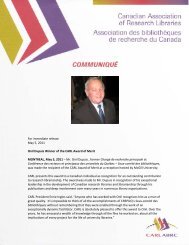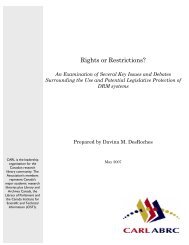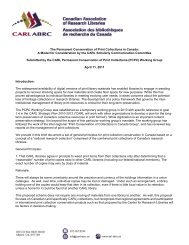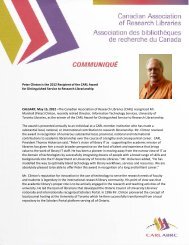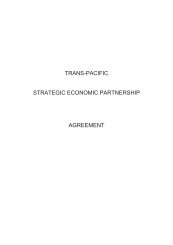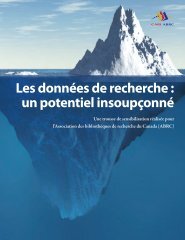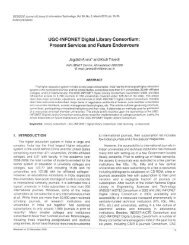PDF - CARL - ABRC
PDF - CARL - ABRC
PDF - CARL - ABRC
Create successful ePaper yourself
Turn your PDF publications into a flip-book with our unique Google optimized e-Paper software.
Outline – Synergies Business and Sustainability Plan Rowland Lorimer 3 of 11<br />
A defining characteristic of the scholarly and research publishing process is its autonomy<br />
from academic institutions, an autonomy that complements and enhances academic<br />
freedom. In the name of academic freedom, considerable effort is expended to achieve<br />
and administer, for example, blind peer review, to ensure that publication decisions are<br />
made solely on the merit of the research. Necessary as such autonomy is, it creates extrainstitutional<br />
dependencies – on the marketplace, on research and other funding agencies,<br />
and on enlightened access 1 to institutional funds.<br />
For the most part in the print era, the market model governed access to the research<br />
record through publication pricing, institutional and individual purchasing, and/or<br />
membership in a scholarly society. While favouring wealthy countries, institutions, and<br />
individuals, the ever-increasing over-exploitation of copyright by commercial science,<br />
technology and medical (STM) journal-publishing firms interfered with effective<br />
knowledge communication to potential beneficiaries.<br />
In the print world, such shortcomings required certain practices and provisions workedarounds<br />
around the shortcomings and inequities of the market model; for instance, the<br />
record existed in libraries while researchers mailed off prints to other researchers who<br />
requested them. In a digital world, the shortcomings of the print-based marketplace<br />
model are more apparent and new. The absence of user-attributable costs beyond firstcopy<br />
costs transforms subscriptions and other purchasing into a bottleneck rather than,For<br />
instance, in a digital world, there is no need to separate the creation of the record from<br />
dissemination. Similarly, the subscription-based model is no longer an imperfect but<br />
understandable but imperfect means for allocating resources. That same absence makes<br />
possible the The absence of user-based costs – printing and distributing a user's personal<br />
copy – transforms subscriptions into an unnecessary bottleneck. The dynamics of digital<br />
technology bring forward consideration of Open Access, that is to say, dissemination to<br />
users without user fees, in more dramatic terms, the universal public distribution in<br />
pursuit of universal dissemination of knowledge and hence the maximization of benefit to<br />
humanity.<br />
Synergies will provide major assistance in transforming the possible future of the digital<br />
world into an operational reality. However, in the final analysis, Synergies can only serve<br />
as a catalyst. The realization of the goal of both easy and public dissemination of research<br />
requires action by the research and post-secondary education community as a whole.<br />
Universities and researchers worldwide and acting in concert must find the means, in<br />
collaboration with research funders, to support the crucial knowledge dissemination role<br />
that journals and scholarly monographs, and other forms of non-commercial scholarly<br />
publications, play.<br />
Synergies Specifics<br />
To achieve the benefits made possible by digital information and communication,<br />
Synergies was designed to provide the following services:<br />
1 I am using the term enlightened here to mean recognition of the greater good of the general community<br />
rather than a responsibility for the interests of one’s own institution.<br />
5/5/10 3 of 11



